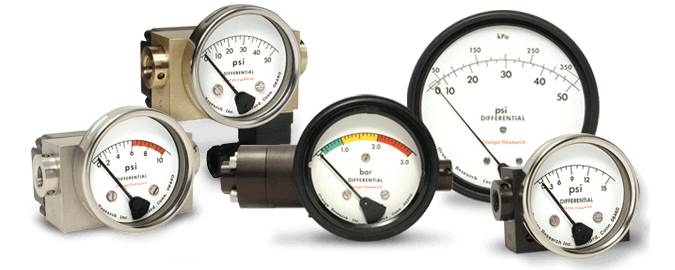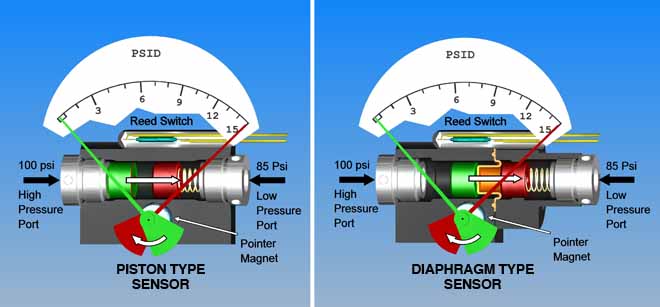Differential Pressure Sensor
Piston Gauge vs. Diaphragm Gauge Comparison
- How a differential pressure sensor works
- Piston gauges are designed for liquid applications
- Diaphragm gauges are appropriate for air, gas or liquids

A 15 psi differential in pressure results in movement of the spring-loaded sensor (piston or diaphragm) from the high pressure port to the lower pressure port (left to right). The sensor magnet induces a rotation in the pointer magnet and the attached pointer. The pointer reflects the 15 psi differential on the dial scale. A reed switch actuates as the differential pressure sensor magnet moves into close proximity.

Piston vs. Diaphragm Differential Pressure Sensors
Our piston differential pressure sensor models are primarily designed for liquid applications. They exhibit a slight amount of bypass as the fluid migrates from the high to the low pressure port. Because gas molecules are smaller, the migration is often deemed too great for the application. We incorporate a flexible Teflon cup seal in our differential pressure sensor, which keeps the bypass very low.
In our diaphragm differential pressure sensor models the high and low-pressure ports are completely isolated from each other. There is no bypass and therefore they are appropriate for air or gas along with liquids. They also come in a variety of sizes allowing for very sensitive measurements. Consider some of our diaphragm differential pressure sensor models for the addition of a diaphragm seal. Contact us for details.
Reach Out to Our Experts
If you have any questions about differential pressure and flow control solutions or about a specific differential pressure sensor model, our team is here to help. Contact us or fill out the form on this page and a member of our team will be in touch shortly.


 WARNING: Some of our products contain Nickel, a chemical known to the State of California to cause cancer. For more information go to:
WARNING: Some of our products contain Nickel, a chemical known to the State of California to cause cancer. For more information go to: